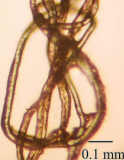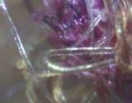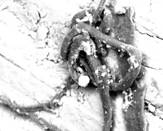|

by Lloyd Pye
from
StarChildProject Website
|
MORGELLONS
  |
STARCHILD

|
|
LEFT - Isolated Morgellons
Fibers under unknown magnification.
RIGHT - Fibers under app. 60x magnification. Fibers are
reported in various colors including red, blue, and
green.
-
These fibers are
extremely durable, said to burn at 1,700 degrees F
without melting.
-
At least some Morgellons
Fibers contain Silica and Silicon
-
The above fibers appear
only in and growing out of soft tissue. Different
"crystalloid" structures appear in bone.
-
Morgellons patients
suffer from a variety of symptoms, including
degeneration of bone and joints, often accompanied
by the presence of Silica products in the tissues.
|
Fibers from the Starchild
bone under 350x scanning electron microscope
magnification.
We do not know the magnification used or have reliable
scales on images of Morgellons' fibers, so there is no
way to determine if the Starchild fibers are of a
comparable size. However, they seem to be significantly
smaller.
-
The Starchild Fibers are
so strong they were not cut cleanly by the Dremel
blade.
-
The Starchild's bone was
found to have elevated levels of Silicon.
-
The Starchild's stringy
fibers are embedded only inside the bone; none of
them grow out of the bone.
-
The Starchild bone shows
no signs of degeneration, and is in fact much
stronger and denser than normal bone.
|
A currently unclassified medical
condition commonly known as "Morgellons
Disease" is a multi-symptomatic condition which, among
other things, often manifests as skin lesions with clusters of
fibers embedded in the skin.
The condition is not yet accepted by the
medical community, despite wide-spread media attention and thousands
claiming to experience symptoms. According to a recent study,
Morgellons fibers appear to be made of high-density polyethylene, a
substance commonly used in the manufacture of fiber optics. Other
crystalloid structures found in the tissues of Morgellons patients
were found to contain silica and silicone.
Many theories about the cause of Morgellons are currently being
circulated, but despite the thousands of Americans who believe they
suffer from the condition, there is not yet a definitive answer. It
has been suggested that Morgellons may be psychosomatic, some
sort of parasitic infection, lice, scabies, a
skin condition caused
by GM cotton or other irritants, and most recently and perhaps most
disturbingly, the result of
nanotechnology sanction by the FDA
for use as a food additive consisting of bacteriophages (viruses
that destroy bacteria - in this case harmful bacteria in foods)
transported in high density polyethylene fibers.
The Morgellons fibers in soft tissue look somewhat like the fibers
in the Starchild's bone, although we have not been able to make a
visual comparison to Morgellons fibers found in bone.
There are obvious similarities,
but at present there is no way to determine if any connection can be
made between the Starchild and Morgellons.
There is a basic test that may immediately rule out Morgellons in
the Starchild, but until we begin the next phase of testing on the
bone, we are unable to perform the test. Morgellons fibers fluoresce
under UV (ultraviolet light - also known as Black Light or Wood's light),
so it is a simple matter of exposing the Starchild fibers to this
light and observing the results. We were not aware of this when we
have previously had the Starchild's fibers exposed, so we did not
run the test. However, the next time we are in that position, we
will definitely run this simple, inexpensive check for fluorescence.
While many photographs of Morgellons fibers are in color, all
available photographs of the Starchild fibers were taken with a
scanning electron microscope which only produces black-and-white
images. Thus, we are unable to draw a color comparison between the
two.
However, regardless of color, there is
enough similarity to warrant further consideration, especially
considering the wide variety in the types and colors of Morgellons
fibers reported. The condition itself was named after a 17th Century
ailment described as causing "harsh hairs" in its patients. That
description did not describe the fibers as having multiple colors or
the "glass-like" appearance that seems to be typical of what is now
termed Morgellons.
The condition as it is today was not really known or identified
until 2002, when a biologist named Mary Leitao coined the
name for the condition and set about improving awareness and
attempting to find an effective treatment.
Such limited information, combined with
the similarities between Morgellons and various parasitic
infections, which many Morgellons researchers suggest leads to
misdiagnosis, makes it difficult to determine if the Morgellons
condition even existed 900 years ago when the Starchild was alive,
and, if so, whether it could have produced these fibers.
|



